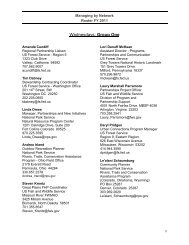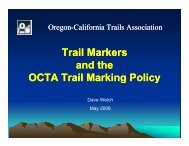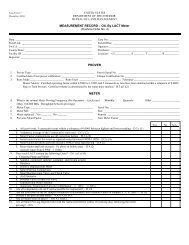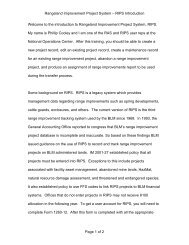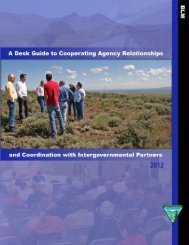Administrative Record: Legal Framework
Administrative Record: Legal Framework
Administrative Record: Legal Framework
You also want an ePaper? Increase the reach of your titles
YUMPU automatically turns print PDFs into web optimized ePapers that Google loves.
Planning/NEPA Forum: <strong>Administrative</strong> <strong>Record</strong> (March 3, 2011): <strong>Legal</strong> <strong>Framework</strong>>>C. Humphrey: So for the rest of the broadcast what we're going to do is talk abouthow to avoid ending up in a similar situation anymore.And now we're going to go to Washington D.C. and we're going to hear about legalframework on project files and administrative records from Attorney-Advisor, LauraDamm.>> L. Damm: Thanks, Cathy. So we all hear the term document, record, administrativerecord, decision file, project file, action file. The question is... what do these terms meanand how are they distinguishable? We heard Linda mention a few of these terms. That'swhat I'm going to try to get at here initially. At the outset I'm going to generally discussseveral concepts relating to records and distinguish them, and I hope that it will be helpfulto carry through throughout the rest of the broadcast.So the general term for all agency documents is "records." It's defined in the U.S. Code at44 USC Section 3301. It's a very lengthy definition. I'm going to summarize three keypoints. The first are that records are documentary materials regardless of their physicalform. What does that mean? That means that records consist of books. They consist ofmaps. They consist of electronic communications, photos.The second is that records are created or received by the U.S. Government in thetransaction of public business.The third is that the materials evidence the government's activities or the data includedhas some informational value.Now I'm going to distinguish four concepts relating to records. The first concept is thatthere are general records requirements under the Federal <strong>Record</strong>s Act. They apply to allof us as federal employees and to federal agencies -- as employees of federal agencies.The important thing to know and remember about this is that the Federal <strong>Record</strong>s Actrequires all employees to make and preserve records containing adequate and properdocumentation of the organization's functions, policies, and decisions. It looks atessential transactions of the agencies, and it's designed to furnish the informationnecessary to protect the legal rights -- legal and financial rights of the government. TheAct, as I mentioned, applies to all of us as employees of the federal government.The second concept which is, you know, one of the most important ones we're going totalk about today and Megan is going to talk in more detail but I will give a quickintroduction, that's a project file. Project files document the agency's work on theirdecisions. It ensures that the decision-maker had access to information sufficient torender a well-reasoned decision.The project file is compiled as the documents are generated or received by thegovernment, and it's a contemporaneous record of the decision. This is where there are alot of other records used too. It's sometimes referred to as a case file, action file, anagency file, official file, issue file, decision file. Today in the broadcast we're going to stickPage 1 of 4
Planning/NEPA Forum: <strong>Administrative</strong> <strong>Record</strong> (March 3, 2011): <strong>Legal</strong> <strong>Framework</strong>to the term project file and our discussion is applicable to all these other terms I justmentioned. As I mentioned, Megan is going to speak more about this later on in thebroadcast.The third concept is an administrative record. So when an agency action is subject tojudicial review, then an administrative record needs to be compiled to respond to thelitigation. The contents of the administrative record can vary depending on the agencyaction that's being challenged and the specific allegations in the litigation.Under the <strong>Administrative</strong> Procedure Act, when a court examines an administrative recordit's going to be looking at whether or not the agency action -- whether or not the agencyacted arbitrary, capricious, an abuse of discretion or otherwise in accord with law. Michaelis going to talk in greater detail about this later on in the presentation. This is just a quickintroduction to this particular concept.The final concept is a FOIA request. I'm sure we're all familiar with these, FOIA requests.A FOIA request is a request from a party for information under the Freedom of InformationAct. You know, documents that are produced in response to a FOIA request may not beidentical to those that are included in your project files or your administrative record. Youknow, it may just be a portion of your project file or a portion of your administrative recordthat's produced.One important thing that I think we can take into the broadcast, though, is that your projectfile is really going to be your basis for your administrative record and also for yourdocuments that are produced in response to a FOIA request. They're going to come fromthe add -- from the project file.The other thing that I just want to highlight again is that, the documents that are producedin response - documents compiled for the administrative record and in response to aFOIA request may not be all the documents in your project files.So as Cathy mentioned, the focus of this broadcast is really on creating a project file andcompiling an administrative record that, as we heard Linda mention and as we're going todiscuss, can be a major task. It can be a big task. It can be exhausting. Hopefully theinformation that we talk about today will help you throughout this process. The thing tokeep in mind, there is information and guidance available. There is help out there. Andthere are people that have lots of experience with this as well that are good resources.We posted the following guidance and information that I'm going to talk about to the KRCweb site, which is at the bottom of your screen.The first thing I want to mention is there is a 2003 Washington Office information Bulletin,IB-2003-074. It's at the bottom of your screen as well. It includes a sample filing plan foran administrative record. It's really for Land Use Planning decisions, not an exhaustivelist, but some ideas about what generally should be included in the administrative record.So it provides a really good starting point.Page 2 of 4
Planning/NEPA Forum: <strong>Administrative</strong> <strong>Record</strong> (March 3, 2011): <strong>Legal</strong> <strong>Framework</strong>There's also State Office guidance available. Utah has a policy and guidance for creatingan electronic administrative record. I don't have an IM number for that. But there's yourpolicy at the bottom of your screen.This policy talks about importance of the administrative record, general advice aboutpreparing an electronic administrative record, converting documents to PDFs, preparingan organized index and hyperlinking, which in my experience, hyperlinking is great,having had to go through an administrative record and find documents for motion practiceand preparing briefs. It also talks about some steps that need to be taken before filing theadministrative record.Arizona has an IM, that is IM-AZ-2010-002, guidance on compiling a decision file and anadministrative record. Just a quick reminder, a decision file is the same thing as a projectfile. It provides guidance on maintaining a project file. It was developed to ensureconsistency among the various field offices in Arizona, provide some contacts forquestions, including our very own Linda Garrison. There's some helpful attachments thatprovides instructions for setting up a project file, and documents that you may typicallysee in a project file, and also a sample document index.I just mention that this guidance is also generally applicable to-- when you're compiling anadministrative record as well, but as we talked about before, it's really going to depend onthe specific allegations in the complaint and in the litigation and the action that's beingchallenged.Oregon has developed an administrative record toolkit, a lit bit of a different approach.The toolkit was developed to assist the field in developing administrative records andproject files. It provides a central location for information about process, steps andprotocols, again specific to Oregon. It describes roles and responsibilities, policyrequirements, provides tips for compiling the administrative record and time lines, which,as we talked about, time lines can be really important when you've got tight deadlines andgot to pull all this information together. It includes examples of coding schemas, achecklist, and a Q&A sheet.Finally, there is some guidance in the BLM NEPA Handbook at chapter 13, section 4. Ittalks about -- gives some information about compiling an administrative record, generalrecordkeeping requirements, including some information about who in your office shouldbe maintaining records and how long they should be maintained.And the final piece of guidance I'm going to talk about is from the solicitor's office. It wasissued in 2006. Standardized guidance on compiling a decision file and administrativerecord. It draws a distinction between a decision file and an administrative record whichwe're going to talk about on this broadcast. If you want some more reading, it's helpful.Discusses documents typically included in the administrative record. And there's a reallygood section on electronic communications. It provides some examples, you know, whenyou get into e-mail chains, attachments, some really good examples in that particularPage 3 of 4
Planning/NEPA Forum: <strong>Administrative</strong> <strong>Record</strong> (March 3, 2011): <strong>Legal</strong> <strong>Framework</strong>section on the solicitor's guidance. Finally, it discusses in more detail the Office of theSolicitor's review process and what happens after our office completes the review.Back to you, Cathy.>> C. Humphrey: Thanks, Laura. That was very helpful. I hope you clarified some of thoseterms, we're starting to clarify some of the terms for those of you out in the field between aproject file administrative record and the different terminology used for those files.And I just want to remind you that all the guidance that Laura mentioned, except for the<strong>Administrative</strong> Procedures Act -- no, the first thing -- the Federal <strong>Record</strong>s Act we don'thave on the KRC page, but everything else we posted to the KRC page. We didn't post allof Oregon's entire admin record toolkit but we posted the most pertinent items and there'sa couple more things I'm going to post still after this one from Oregon I think will behelpful. And Anne Boeder, who you will hear about in a few minutes, can answer anyquestions about the Oregon toolkit.If your state has any additional guidance we would like to know about it. As Laura said wehave Utah, Arizona, and some stuff from Oregon, but if anybody else has anything, sendit to me and I'll add it to the KRC page with all the others.Page 4 of 4




